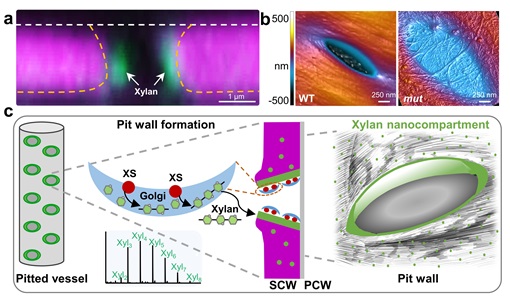All living organisms can self-organize into a highly efficient operation system, whose robustness is maintained by compartmentalization of cells to various specialized subcellular structures. For example, lipid bilayers and proteins usually form micro- and nanocompartments via clustering and phase separation. Saccharides are an important class of biomacromolecules that are capable of compartmentalization. Due to the difficulties in probing sugar molecules, very few saccharide-based structures have been characterized. Our knowledge about nanoscale glycan compartments with specific functions is fairly scarce.
In plants, more than two thirds of carbon dioxide fixed by photosynthesis are converted into structural polysaccharides to construct cell walls surrounding every plant cell, thereby forming tissues, organs and individual plantlet. Xylem vessels of plant vasculature display notable cell wall compartments, such as annular/spiral patterns (protoxylem) and reticulate/pitted patterns (metaxylem). However, how the extracellular polysaccharides self-organize into nanocompartments is unknown.
The group of Prof. ZHOU Yihua from the Institute of Genetics and Developmental Biology (IGDB), Chinese Academy of Sciences (CAS), recently reported an identification of unprecedented xylan nanocompartments at the pit borders of xylem vessels in rice and Arabidopsis using super-resolution confocal microscopy.
A series of genetic and biochemical analyses revealed that these nanocompartments are produced by the activities of IRREGULAR XYLEM (IRX)10 and five homologues of the glycosyltransferase 47 family. Rice IRX10, a major member contributing to xylan synthesis in vessels, can mediate xylan chain elongation and initiate the generation of xylooligomers without an acceptor, indicating a de novo synthetic machinery.
Furthermore, atomic force microscopy revealed the nanoscale wall topography around pit boundaries sustained by the xylan nanoclusters. Surprisingly, disruption of the xylan nanostructure leads to abnormal and fused pits with improperly packed cellulosic nanofibrils, resulting in reticulate-like patterns that compromise vessel robustness. Moreover, through investigating the vessel pit size and growth traits in 42 core rice accessions, pit size was found correlated with some agronomic traits, such as plant height.
Hence, using multiple cutting-edge approaches, this study outlines a mechanism of how xylans are synthesized, how they are assembled into nanocompartments and how the nanocompartments sustain cell wall pit patterning to support efficient water transportation throughout the plant body.
The xylan nanostructures at pit boundary are analogous to merrow edges of buttonholes preventing thread releasing; its role is to sustain cell wall coherence, which deepens understanding of cell wall patterning established from a cytosolic-based perspective. More miraculous polysaccharide-based nanostructures are expected. Furthermore, the discovery of a de novo xylan synthase opens new avenues for rational manipulation of this polymer.
In summary, this study bridges the knowledge gap between polysaccharide synthesis and functional structures, evoking rethinking of diverse physiologic processes in plants and providing new perspectives for precision design of crops.
This work entitled “Xylan-based nanocompartments orchestrate plant vessel wall patterning” was published in Nature Plants on Mar 22, 2022 (https://doi.org/10.1038/s41477-022-01113-1). Dr. WANG Hang and Ph.D student YANG Hanlei are the first authors. Prof. ZHOU Yihua and Dr. ZHANG Baocai are corresponding authors. Prof. Staffan Persson from the University of Copenhagen joined in the study.
This research was supported by the National Natural Science Foundation of China, the Strategic Priority Research Program of CAS, Youth Innovation Promotion Association of CAS, and the State Key Laboratory of Plant Genomics.
 Xylan-based nanocompartments govern vessel wall patterning. a, Z-plane of a pit in wild-type xylem vessel wall probed using xylan-recognized antibodies (green). b, AFM images of vessel walls, showing disorganized cellulosic nanofibrils in the mutant. c, Model for xylan nanocluster formation in pitted vessel cells by xylan synthase (XS). The embedded figure is mass spectrography of the reaction products catalyzed by IRX10 without an acceptor substrate. (Image by IGDB)
Xylan-based nanocompartments govern vessel wall patterning. a, Z-plane of a pit in wild-type xylem vessel wall probed using xylan-recognized antibodies (green). b, AFM images of vessel walls, showing disorganized cellulosic nanofibrils in the mutant. c, Model for xylan nanocluster formation in pitted vessel cells by xylan synthase (XS). The embedded figure is mass spectrography of the reaction products catalyzed by IRX10 without an acceptor substrate. (Image by IGDB)
Contact:
Dr. ZHOU Yihua
Institute of Genetics and Developmental Biology, Chinese Academy of Sciences

 CAS
CAS
 中文
中文




.png)
